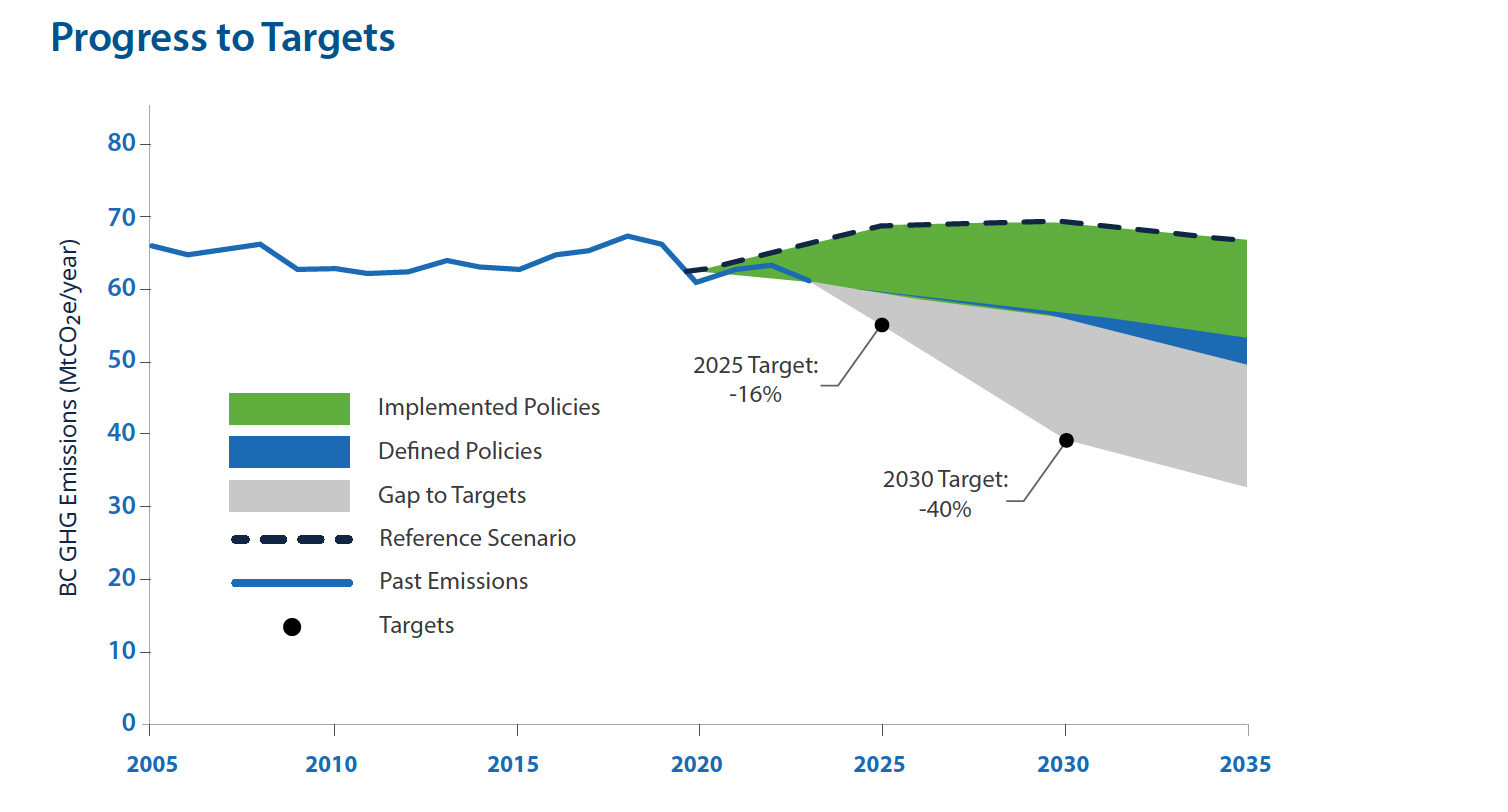Provincial projections of greenhouse gas emissions
B.C. produces forecasts of future greenhouse gas (GHG) emissions in order to assess progress toward climate goals and the impact of climate policies. These projections are updated annually.
On this page
- B.C.'s emissions estimates
- Information on modelling
- Near-term outlook to 2027
- CleanBC projections to 2030
B.C.'s emissions estimates
In keeping with commitments in the Climate Change Accountability Act, B.C. complements its annual reporting on historical GHG emissions with estimates of GHG emissions for the years ahead.
Information on modelling
B.C. uses modelling as a tool to analyze climate policy and its impact on provincial GHG emissions. Modelling assumptions are updated as new data becomes available.
Even complex models do not fully account for all the factors that will shape the future, such as the emergence of new technologies and global shocks like pandemics and wars. The resulting projections are not intended to predict the future, only to help us understand how different choices and changes could affect our path forward.
Near-term outlook to 2027
B.C.’s near-term outlook estimates emissions for the four years following the most recently available emissions data – up to and including 2027. The outlook suggests a decline in emissions for 2024 through 2027, taking into account substantial uncertainty about their future trajectory.
The forecasted emissions decline from 1.1 MtCO2e to 61.0 MtCO2e in 2024, 60.3 MtCO2e in 2025, 59.4 MtCO2e in 2026 and 58.6 MtCO2e in 2027. This forecasting exercise is useful for understanding how emissions may evolve based on observed trends, but it may not capture all factors that are expected to impact emissions over the coming years (including scheduled changes in CleanBC policy stringency). To account for uncertainty, B.C. estimates that in 2027 there is a 50 percent likelihood that emissions will be within +/- 3.6 MtCO2e of the point estimate and an 80 percent likelihood that emissions will be within +/- 6.8 MtCO2e of the point estimate.
CleanBC projections to 2030
Emissions projections to 2030 reflect the expected longer-term impact of CleanBC policies. These projections are developed through energy-economy modelling of various scenarios to assess policy-driven changes in the trajectory of emissions. Our latest projection suggests that CleanBC will mitigate the emissions impacts of population and economic growth and lower emissions over time.
In previous years, the projection to 2030 relied on a scenario where all CleanBC Roadmap to 2030 policies and programs were fully implemented.
This year, like in 2024, the projection relies on scenarios that consider the current policy landscape:
- Implemented scenario - includes all CleanBC policies and measures in place as of June 1, 2025
- Defined scenario - adds CleanBC policies and measures that are sufficiently advanced in policy development to be accurately assessed through the modelling exercise
A reference scenario, which does not consider CleanBC, continues to be used for comparison.
Progress towards B.C.'s 2030 targets

Projection results
Under the implemented scenario, B.C.’s emissions decline by 14 percent from 2007 levels, achieving 35 percent of the 2030 GHG reduction target. The defined scenario shows similar reductions, with emissions declining by 15 percent from 2007 levels, achieving 37 percent of the 2030 target. To meet the 2030 target, an additional 16.4-16.9 MtCO2e of reductions would be required.
The current policy landscape does not put the Province on track to meet its 2030 targets. However, progress can be measured in different ways and B.C. is reducing emissions intensity while growing a cleaner economy. For B.C., a key challenge has been overcoming the emissions associated with the highest provincial economic growth and second highest population growth in Canada over this period. For 2023, B.C. had the third lowest economic GHG intensity (GHGs per dollar of GDP) among provinces and 4th lowest GHG emissions per capita. These measures do not include land use change emissions to allow comparability with other provinces. Additionally, a number of measures developed under CleanBC, such as the zero-carbon building code, will begin reducing emissions around 2030, or shortly thereafter, helping the Province to make progress towards our targets in 2040 and 2050
